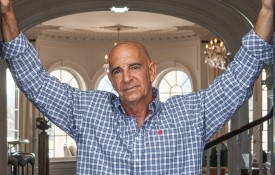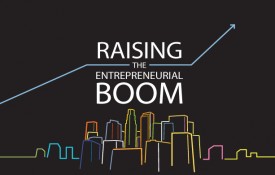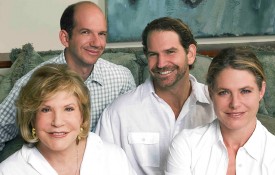Introducing the first of a multi-part series of “Profiles in Failure.” Written by Dun & Bradstreet Vice Chairman & Bryant Stibel Co-Founder Jeff Stibel, each profile will examine the failures overcome by some of humanity’s most successful icons. First up, the Oracle of Omaha – Warren Buffett.
When you think of Warren Buffett, chances are “successful” and “rich” come to mind. Look no further than Wikipedia, which highlights Buffett as being “widely considered the most successful investor of the 20th century.” (While Wikipedia may not always be a beacon of truth, it is certainly accurate in this case.) Buffett is known for his wisdom and patience and people actually make annual pilgrimages to Omaha to hear him speak. What many people don’t know is that his purchase of Berkshire Hathaway – his crowning achievement as the company is now worth more than $300B – was an epic failure forcing Buffett to completely transform the company to make it profitable.
Buffett’s involvement in Berkshire Hathaway started in 1962 as an investment similar to his other purchases. Analysts calculated the stock was worth $19.46 a share, but it could be bought for a mere $7.50, so Buffett bought some “cheap” stock, planning to sell it back to the company when the price rose. After a time, Berkshire Hathaway’s President – Seabury Stanton – got wind of Buffett’s stock accumulation and called him to his Massachusetts office for a meeting. He asked at what price Buffett would be willing to sell, and Buffett said he’d sell for $11.50 a share if there was a tender offer.
Shortly thereafter, Stanton issued a tender offer of $11.37 per share. The young Buffett was livid; he felt that Stanton was trying to pull one over on him. Instead of renegotiating or holding his stock until a better offer came around, he started looking for even more stock to buy, vowing to buy a controlling interest in the company just so he could fire Seabury Stanton.
Berkshire Hathaway in the 1960s was nothing like the powerful conglomerate it is today. It was a lowly textile company that imported raw cotton and turned it into cloth. Before air conditioning was invented, the company addressed an important need, as mills had to be located far away from heat and humidity. But by the 1960s air conditioning was commonplace, labor was cheap, and labor and raw materials were even cheaper overseas. By the time Buffett started buying stock, New England textile mills were in dire straits, including Berkshire Hathaway.
Yet Buffett was determined to own the company, driven by his disdain of Seabury Stanton. He convinced others to sell him their stock until he had collected enough to control the Board. Seabury, seeing the writing on the wall, resigned, and Buffett was elected Chairman of the Board and hired Seabury’s replacement. Despite new management, the textile mill continued to disintegrate. Buffett first poured money into Berkshire Hathaway and then tried to sell it, but no one would buy it.
“His arrogance resulted in failure, but it also gave him enough confidence and persistence to move beyond that failure. More impressively, he succeeded by completely giving up on the original business model.”
Hard Lessons Learned
Arrogance, more than anything else, led Buffett down this path. He was young and full of hubris that clouded his thinking. He felt Berkshire Hathaway was undervalued when it was not, that its CEO was incompetent when he was not, and that he himself would do a better job leading the company than the very managers who understood the business best.
As a result, Berkshire Hathaway was an immediate disaster for Buffett. In his biography, The Snowball, he put it this way:
You walk down the street and you see a cigar butt, and it’s kind of soggy and disgusting and repels you, but it’s free…and there may be one puff left in it. Berkshire didn’t have any more puffs. So all you had was a soggy cigar butt in your mouth. That was Berkshire Hathaway in 1965. I had a lot of money tied up in the cigar butt….I would have been better off if I’d never heard of Berkshire Hathaway.
For better or worse, Buffett was stuck and his business was finished. Where most people would have given up, however, Buffett kept Berkshire Hathaway alive, saved it from bankruptcy, and helped nurse the company back to life. His arrogance resulted in failure, but it also gave him enough confidence and persistence to move beyond that failure. More impressively, he succeeded by completely giving up on the original business model.
Buffett went back to the drawing board and reimagined Berkshire Hathaway, not as a textile company but as an investment company. He diversified its holdings, acquiring companies in different industries to keep Berkshire Hathaway alive. Though it is doubtful that he would consider doing something like that again, the Buffett of today has enough wisdom to know that sometimes admitting defeat is the best path: “Should you find yourself in a chronically leaking boat, energy devoted to changing vessels is likely to be more productive than energy devoted to patching leaks.”
Aged With Humility
Over time, Buffett’s arrogance has all but disappeared. This is all the more surprising given his enormous success: he is the third wealthiest person in the world. He turned Berkshire Hathaway into one of the world’s largest holding companies with ownership in businesses such as Coca-Cola, Apple, and Goldman Sachs. This kind of success would inflate the egos of many people, but for Buffett, the experience was a humbling transformation.
Buffett practices humility and surrounds himself and his family with constant reinforcement of those principles. Most people are surprised to learn how a man worth nearly $70B raised his children:
Our kids had a very normal growing-up. I mean, they’ve only and I’ve only lived in one primary house that I’ve owned in my life, and I bought that in 1958. So they did not see us moving into progressively fancier houses; they did not ride in private planes. They went to school on the bus. Every member of the Buffett family in Omaha has gone to a public school. They went to the same school that their mother had gone to. They went to the same high school that she’d gone to. We were living in an area where, in today’s dollars, our neighbors were making maybe $75,000 a year, or something of the sort. So they never really thought that we were economically different.
Buffett made a series of poor decisions which forced him to fight his way through a hard lesson learned. He remained persistent throughout, and rather than giving up and allowing Berkshire Hathaway to fail, he morphed the business and himself into one of the greatest success stories in history.
[For more of Jeff Stibel’s Profiles in Failure articles, click here]














































